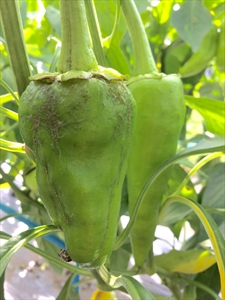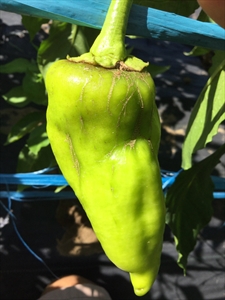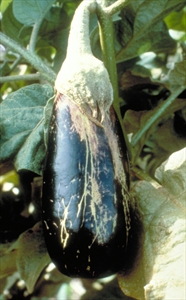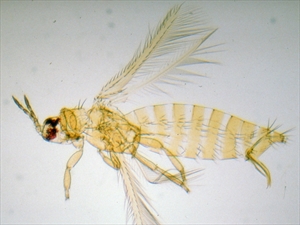Melon thrips
Pacific Pests, Pathogens and Weeds - Online edition
Pacific Pests, Pathogens & Weeds
Melon thrips (106)
Thrips palmi (but note, no species of palms are host!).
Asia, Africa, North, South and Central America, the Caribbean, Europe, Oceania. It is recorded from Australia, American Samoa, Federated States of Micronesia, French Polynesia, Guam, New Caledonia, Palau, Papua New Guinea, Samoa, and Wallis & Futuna.
Recorded on many plant families, including cabbage, cucumber, legumes, potato and many ornamentals and weeds. Important crop hosts are French beans, capsicum, chilli, eggplant, melon, potato, tomato and zucchini.
Thrips have piercing mouthparts and these are used to suck out cell contents. Major damage occurs on the undersides of new or old leaves, especially alongside the midribs and veins. Large numbers of thrips cause the leaves to appear silvery or brown, and to curl upwards, becoming boat-like, stunted and deformed. Fruits, too, are deformed and show feeding scars (Photos 1-4), and may drop prematurely.
Thrips palmi are about 1 mm long, narrow, yellow with two pairs of wings (Photo 5). Eggs are laid in young leaves, flowers and fruits; they hatch in 3-4 days and the nymphs look like adults except that they are about half the size and without wings. There are several stages: two on the host plants, which feed actively like the adults, and two - the pre-pupae and pupae - in the soil, which do not feed. After emergence from the pupae the adults burrow to the soil surface and then climb or fly to host plants. The period from egg laying to adult emergence is 10 to 12 days at 30°C, and 14 to 16 days at 25°C. The adults live for 30-90 days.
Thrips palmi is a major pest. Populations increase rapidly causing severe injury. Plants can be deformed or killed by heavy infestations. There are two types of damage caused by Trips palmi: (i) direct damage caused by feeding, and (ii) indirect damage caused by spreading Tomato spotted wilt (TSWV).
Look for insects that are very small, narrow, and just visible to the naked eye. The adults are yellow, with wings; the nymphs are yellow or white, without wings. Look for the silvering or bronzing of the top surfaces of leaves, especially along the midribs and veins.
The management of Thrips palmi involves reducing the damage from direct feeding, as well as the damage done from spreading TSWV.
NATURAL ENEMIES
Natural enemies are not well recorded for Thrips palmi, although there have been introductions of predatory bugs (Orius spp.) and parasitic wasps to control other species in several countries.
CULTURAL CONTROL
Before planting:
- Avoid overlapping planting of susceptible crops to minimise spread of Thrips palmi from one crop to the next.
During growth:
- Weed around crops, destroying hosts of thrips. Weeds that are flowering are particularly attractive to thrips as they feed on pollen. If using herbicides, destroy weeds well before planting, not as crops are planted, otherwise the thrips may migrate from the wilting weeds to the young crop plants.
- Make sure seedling production areas are well away from field crops, and kept weed-free.
- Use thrips-proof netting for seedling production areas if thrips are a problem, or spray regularly with an insecticide.
After harvest:
- Collect the remains of crops and other debris and burn it.
RESISTANT VARIETIES
There are varieties of capsicum and tomato that are resistant to TSWV. Use these varieties together with cultural control measures to keep populations of thrips low; otherwise, the resistance may fail as it is controlled by a single dominant gene.
CHEMICAL CONTROL
Note, reducing thrips populations by use of appropriate insecticides can help lower virus spread. But insecticides are often of limited value in TSWV control because virus spread from weeds is such an important source of infection. Also, thrips only require a short feeding time before they are able to transmit the virus.
Use insecticides as follows, but note that frequent use of broad-spectrum synthetic insecticides may also lead to development of insecticide resistance in thrips populations:
- Use horticultural oil (made from petroleum), white oil (made from vegetable oils), or soap solution on the growing plants (see Fact Sheet no. 56). The spray will not kill all of the thrips, but it will suppress the population enough to allow predator and parasite numbers to build up and start to control them.
- Several soap or oil sprays will be needed to bring the thrips under control. It is essential that the underside of leaves and terminal buds are sprayed thoroughly since these are the areas where the thrips congregate. It is best to spray between 4 and 6 pm to minimise the chance of leaves becoming sunburnt.
- White oil:
- 3 tablespoons (1/3 cup) cooking oil in 4 litres water.
- ½ teaspoon detergent soap.
- Shake well and use.
- Soap:
-
Use soap (pure soap, not detergent).
- 5 tablespoons of soap in 4 litres water, OR
- 2 tablespoons of dish washing liquid in 4 litres water.
-
- White oil:
- Commercial horticultural oil can also be used.
- Use neem to discourage adults from feeding and laying their eggs on the plants (see Fact Sheet no. 56).
- Do not use broad-spectrum insecticides such as dimethoate (under review in Australia, and not allowed for use in home gardens), malathion or a synthetic pyrethroid. They have a greater effect on the natural enemies of melon thrips than on the thrips.
____________________
When using a pesticide, (even a biopesticide) always wear protective clothing and follow the instructions on the product label, such as dosage, timing of application, and pre-harvest interval. Recommendations will vary with the crop and system of cultivation. Expert advice on the most appropriate pesticide to use should always be sought from local agricultural authorities.
AUTHOR Grahame Jackson & Mani Mua
Information from Waterhouse DF, Norris KR (1987) Thrips palmi. Biological Control Pacific Prospects. Inkata Press; and CABI (2021) Thrips palmi (melon thrips). Crop Protection Compendium. (https://www.cabi.org/isc/datasheet/53745); Melon thrips Thrips palmi. Department of Environment Food & Rural Affairs. (https://planthealthportal.defra.gov.uk/assets/factsheets/thrips-palmi-factsheet.pdf). Photo 1 Guyot J, INRA, Pointe-a-Pitre, Bugwood.org. Photo 2 Plant Protection Service Archive, Plant Protection Service, Bugwood.org.
Produced with support from the Australian Centre for International Agricultural Research under project PC/2010/090: Strengthening integrated crop management research in the Pacific Islands in support of sustainable intensification of high-value crop production, implemented by the University of Queensland and the Secretariat of the Pacific Community.








